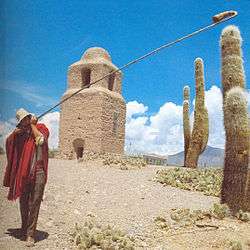Erke
The erke (alternatively erque, coroneta, or quepa) is a large labrophone (lip reed) instrument native to the Gran Chaco of Bolivia, northern Chile, and Argentine Northwest.[1]

Construction
The erke is composed of two or more lengths of cane joined at the ends to form a single tube. The internal nodes of the canes are removed and the exterior is often wrapped with gut or wool. The end often has an amplifier made of cow horn or brass. The instrument is blown through at the other end, and may be three to seven metres in length.
History
Although in the latter half of the 20th century Andean folkloric musical groups have used the erke for secular music, among the indigenous and criollo peoples of the Andes the erke is used solely for ritual purposes.
Traditionally but not commonly, only adult men play the erke, and it is considered profane to play the erke outside of a ritual context. The erke is commonly played during winter, as it is believed that playing it in spring or summer can bring snow.[2]
Similar instruments
Among the Mapuche people, there exists a similar instrument called the trutruca.
References
- Malena Kuss (2004). Music in Latin America and the Caribbean: an encyclopedic history. University of Texas Press. pp. 310–. ISBN 978-0-292-70298-1. Retrieved 26 April 2011.
- Australian Rock Art Research Association (2005). Rock art research: the journal of the Australian Rock Art Research Association (AURA). Archaeological Publications. p. 25. Retrieved 26 April 2011.
